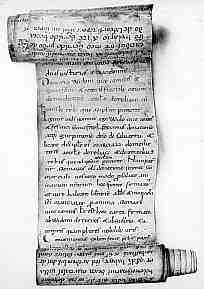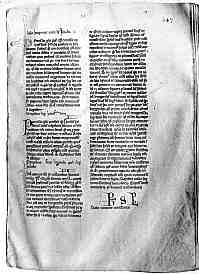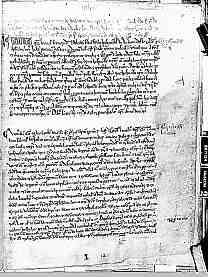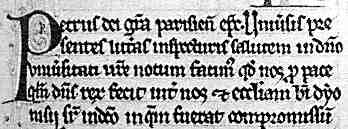







If you are looking at this page without frames, there is more information about medieval writing to be found by going to the home page (framed) or the site map (no frames).
| Monastic Cartularies | ||||
| The existence of monastic records known as cartularies provides a pile of evidence for the history of monastic houses, as well as representing something of the development of literate process in relationships between church and state, and between different branches of the church. Essentially, a cartulary is a copy of all the charters pertaining to a particular monastic house, drawn up and curated by that monastery as an archived record. The compilation of these documents began with the major Benedictine monasteries, but eventually spread to ecclesiastical institutions of all kinds. | ||||
| The earliest surviving cartularies are from some German monasteries of the 9th century. | ||||
 |
Entry from a cartulary of 828 from the monastery of Fulda. (From Steffens 1929) | |||
| The process really took off around the 11th and 12th centuries. It is no coincidence that this is contemporaneous with the development of literate process in government, and is somewhat in advance of properly organised royal chancery archives. Most cartularies are in the form of a codex, but there are a few in the form of a roll. |
 |
|||
| An 11th century cartulary in the form of a roll, of the almshouse of Saint-Martial in Limoges (Archives hospitalières de Limogers, A 2). (From De Boüard 1929) | ||||
| The cartulary could be organised in different ways, and was presented in varying degrees of formality. What they all had in common is that they were not single sheet documents bound together, but copies entered continuously, maybe with several documents to a page. | ||||
 |
 |
|||
| At left, page from a 13th century cartulary of St Denis, Paris (Archive Nationale, LL 1157, f.347). (From de Boüard 1929, Pl. XXIX) At right, page from a cartulary of the Augustinian Hospital, later Priory, of St Mary, Little Wymondley (British Library, add. ms. 43972, f.12), by permission of the British Library. | ||||
| In the above examples, the St Denis cartulary is laid out in two columns like a Bible or book of liturgy, with enlarged decorative initials on each of the three entries on the page. The Little Wymondley cartulary is written in a single column, with a marginal note on each entry. | ||||
| The entries might be organised hierarchically, with important documents like papal bulls or foundation charters at the beginning, working down through grants from the king to those of the high ranking aristocracy to the dealings with the local gentry; or they might be organised geographically, dealing with property in different parts of the country. A combination of these schemes could also be employed. | ||||
| They were sometimes compiled in an additive manner, containing the work of numerous scribes over time, on other occasions they were reproduced at one time from pre-existing records. They could be produced in formal book hand, with decorative initials and other characteristics of a high value volume, or written out in less formal cursive scripts as a plain working document. | ||||
 |
 |
|||
| Above, sample of script from the St Denic cartulary shown above. At left, decorative initial from a mid 13th century cartulary of Reading Abbey (British Library, Harley 1708, f.47). (From The New Palaeographical Society 1906) | ||||
| The St Denis cartulary is written in a formal Gothic textura book hand, as befits its formal, liturgical layout. The sample at left, from the Reading Abbey cartulary, sports very intricate and finely drawn decorative initials. The script is a formal charter hand which does not differ too much from a Gothic textura book hand. The example below from Little Wymondley shows a much less formal, cursive document hand, quite compact and heavily abbreviated. | ||||
| Below, a few lines of text from the Little Wymondley cartulary shown above. | ||||
 |
||||
| Because of the habit of isolated sheets of parchment fluttering away into oblivion, the texts of many more charters survive in these bound volumes than survive as the original single sheet documents. The cartularies themselves seem to have attracted the attention of those antiquarians of the 17th and 18th centuries who, becoming aware of a totally changed world slipping away from them forever, sat down and copied them out verbatim. Many charters survive only in the form of later antiquarian copies from the cartularies which have, in their turn, disappeared. Where did they go? I don't know. Perhaps the antiquarians snaffled them as unappreciated treasures. | ||||
 |
||||
| Segment from a copy of a monastic cartulary made in 1627, from a private collection. | ||||
| This all adds up to a rich historical resource, but one with a few cautionary warnings. A bit of historical background is necessary to explain why. | ||||
|
|
||||
|
If you are looking at this page without frames, there is more information about medieval writing to be found by going to the home page (framed) or the site map (no frames). |
||||